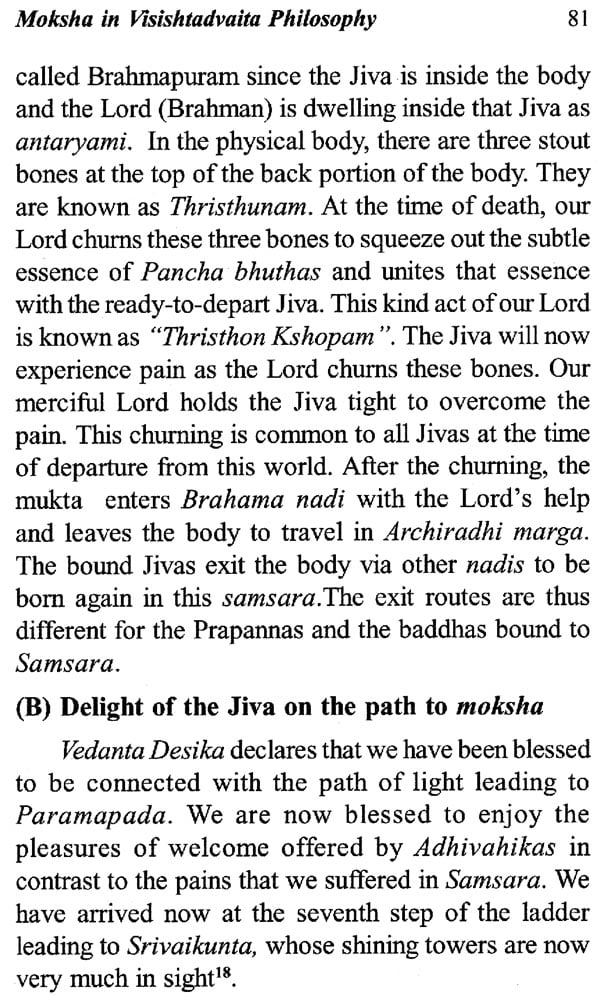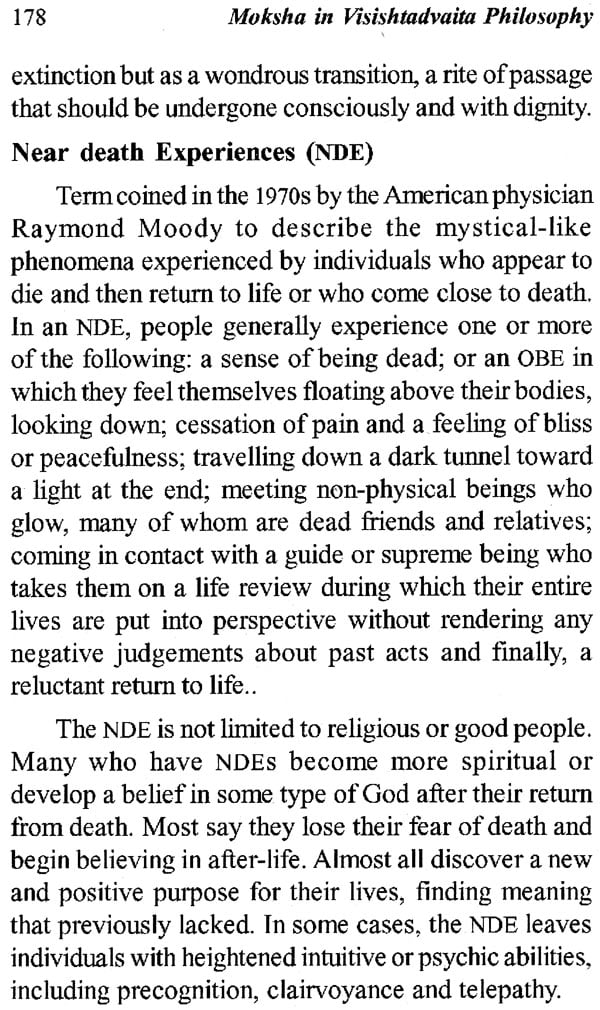
Moksha in Visishtadvaita Philosophy
Book Specification
| Item Code: | NAW773 |
| Author: | R. Parthasarathy |
| Publisher: | Tirumala Tirupati Devasthanams, Tirupati |
| Language: | English |
| Edition: | 2016 |
| Pages: | 204 |
| Cover: | PAPERBACK |
| Other Details | 8.50 X 5.50 inch |
| Weight | 190 gm |
Book Description
(b) Ilia (the way or means) by which individual soul reaches the ultimate destination.They are (I) Karma yoga, (ii) Gnana yoga, (iii) Bhakti yoga, (iv) Prapatti and (v) Acharyabhimana (devotion to Acharya) (c) Purushartha (the goal of human endeavour) is fivefold namely Dharma, Artha, Kama, Kaivalya and Moksha. While Dharma is religiosity, Artha is economic development, Kama is sense gratification, Kaivalya is enjoyment of the soul (atmaanubhava) and Moksha is enjoyment of the Lord and Liberation (Bhagavad Anubhava). Out of all these Moksha is considered as the parama Purushartha, the Supreme goal of human endeavour.
The objective of this work "Moksha in Visishtadvaita Philosophy," is to present the concept of Moksha, the eligibility of persons for attainment, the departure ofthe soul, the journey ofthe soul through the Archiradhi marga to Srivaikunta, where he attains the ultimate goal, namely mukti. This mukti is Paripurna Brahmanubhava and is of the nature of perfect and full enjoyment of Paramatma. This Preface enjoyment does not stop there, but overflows into service to Paramatma - service of all kinds, at all times and under all situations, for which there is no end - in a region from which there is no return, (Sarvadesa-sarvakala-sarvavasthochith-sarvavidha-kainkarya) as elucidated in Visishtadvaita Philosophy.
Etymology: Moksha is derived from the root mean (in Sanskrit) which means free let go, release, liberate. In Vedas and early Upanishads, the word mukhyat (in Sanskrit) appears which means to be set free or release - such as of a horse from its harness.
The definition and meaning of Moksha varies among various schools of Indian religions. Moksha means freedom, Liberation from rebirth or samsara. This Liberation can be attained while one is on earth (jivanmukti), according to Advaita or eschatologically (karmamukti, videhamukti); as per Dvaita and Visishtadvaita, Moksha is the state of paripurna-brahmanubhava (oneness with Brahma, the One Supreme Self), a state of knowledge, peace and bliss. Moksha is also called vimoksha, vimukti and mukti, means emancipation, Liberation or release. In eschatological sense, it connotes freedom from samsara "the cycle of death and rebirth". In epistemological and psychological sense, moksha connotes freedom, self-realization and self-knowledge.
Any intelligent person will have queries like "Why am I suffering through the process of birth, old age, disease and death?", "What is death?", "What happens after death?", "What is Liberation?", "How does and by what means does one achieve Freedom?" This work is dedicated to provide answers to all the above questions and much more.
The very first step in religion is the understanding the true nature of the soul (Jiva), and the realization that the physical body is not the soul. The visible body is not the whole reality. The Jiva is not only different from the body but also from the various sense organs and mind which vary from body to body. The body and sense organs will perish, but the soul (Jiva) is indestructible, (avinashika) is not born and die (najayate mriyateva) and is eternal (nityam). The soul is not apparently visible, is incomprehensible and unchangeable.
The Chandogya- Upanishad, states that what produces a child is not the father or the mother. It is the whole cosmos that produces the child. The universe is the parent of this little baby. It may be a human baby, a sub-human one or a super-human form. The Brihadaranyaka-Upanishad states in its own beautiful style, the way in which the soul can assume various forms, psychic as well as physical. The goldsmith does not create new gold. He only creates a new shape of the gold after melting it in a furnace.
That is how he prepares ornaments, etc. Likewise, the material forces, earth, water, fire, air, and sky are the elements out of which bodies are formed. The present body is made up of these elements. The carpenter can arrange the pieces of wood in various ways according to the need or the requirement of the time. But the wood is the same. It is not a new wood that he is using. Likewise, they are the same elements that work wherever you go, whatever is the birth that you take, and whichever be the shape the soul assumes in whichever realm, in its new incarnation. The psychology or philosophy of rebirth is "As is the desire, so is the will; as is the will, so is the action. And as is the action, so is the consequence, or the result there of". The actions which were performed earlier, having produced results correspondingly, bind the soul once again, so that the body which was shed has gone, but a new body comes."
Book's Contents and Sample Pages
















